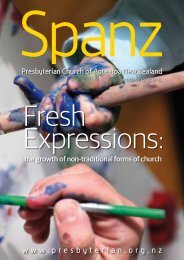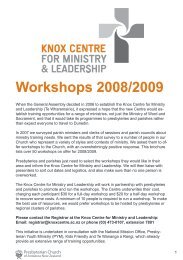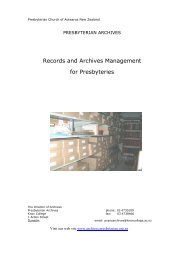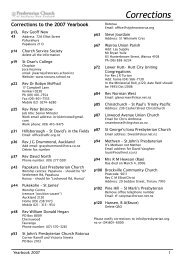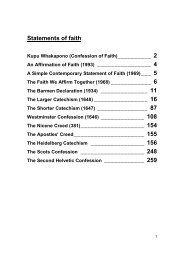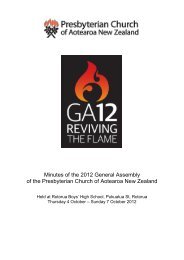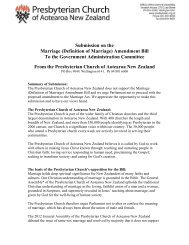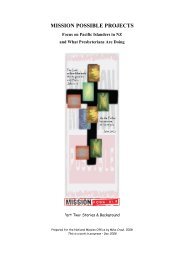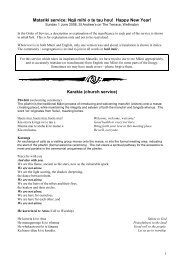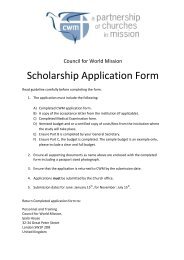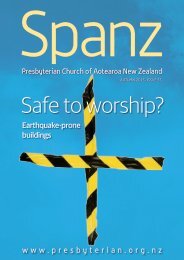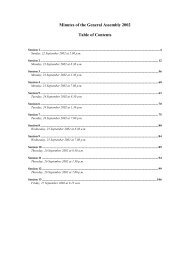Cultural diversity and unity in Christ: the Presbyterian Church of ...
Cultural diversity and unity in Christ: the Presbyterian Church of ...
Cultural diversity and unity in Christ: the Presbyterian Church of ...
Create successful ePaper yourself
Turn your PDF publications into a flip-book with our unique Google optimized e-Paper software.
<strong>the</strong> British forces who were seiz<strong>in</strong>g <strong>the</strong>ir l<strong>and</strong>s, <strong>and</strong> many <strong>of</strong> <strong>the</strong> m<strong>in</strong>isters <strong>and</strong> missionaries act<strong>in</strong>g as<br />
chapla<strong>in</strong>s, <strong>the</strong>y deserted <strong>the</strong> faith <strong>in</strong> droves (“You taught us to turn our eyes to heaven to pray <strong>and</strong><br />
while we look<strong>in</strong>g up you took <strong>the</strong> l<strong>and</strong> from under our feet”). A religious consequence was <strong>the</strong><br />
spr<strong>in</strong>g<strong>in</strong>g up <strong>of</strong> many new forms <strong>of</strong> faith, what would now be called New Religious Movements,<br />
comb<strong>in</strong><strong>in</strong>g <strong>Christ</strong>ian, or more especially Old Testament, beliefs with traditional Maori beliefs <strong>and</strong><br />
culture. The most significant <strong>of</strong> <strong>the</strong>se <strong>in</strong> <strong>the</strong> 19 th century was R<strong>in</strong>gatu, founded by <strong>the</strong> charismatic<br />
warrior chief Te Kooti, while <strong>in</strong> <strong>the</strong> 20 th century a very significant movement was <strong>the</strong> Ratana <strong>Church</strong>,<br />
founded by <strong>the</strong> Maori prophet <strong>and</strong> faith healer Ratana, <strong>the</strong> ‘mangai’ or mouthpiece <strong>of</strong> God.<br />
Unfortunately, like all <strong>the</strong> earlier expressions, this was regarded by <strong>the</strong> European churches as be<strong>in</strong>g<br />
outside <strong>the</strong> fold <strong>of</strong> true <strong>Christ</strong>ianity <strong>in</strong>stead <strong>of</strong> embraced as a local contextual adaptation.<br />
The church l<strong>and</strong>scape began to change significantly from <strong>the</strong> late 1960s, firstly with <strong>the</strong> decl<strong>in</strong>e <strong>of</strong> <strong>the</strong><br />
ma<strong>in</strong>l<strong>in</strong>e churches <strong>and</strong> growth <strong>of</strong> more <strong>in</strong>dependent evangelical, charismatic <strong>and</strong> Pentecostal<br />
churches, particularly <strong>the</strong> latter. The second major factor br<strong>in</strong>g<strong>in</strong>g about change was <strong>the</strong> arrival <strong>of</strong><br />
considerable numbers <strong>of</strong> <strong>Christ</strong>ians from non European countries, who also brought with <strong>the</strong>m <strong>the</strong>ir<br />
own versions <strong>of</strong> church from <strong>the</strong>ir homel<strong>and</strong>s.<br />
The first wave <strong>of</strong> <strong>the</strong>se, as <strong>in</strong>dicated above, came from <strong>the</strong> Pacific Isl<strong>and</strong>s <strong>and</strong>, with <strong>the</strong>ir churches<br />
hav<strong>in</strong>g been established by Anglican, <strong>Presbyterian</strong>, Congregational, Methodist <strong>and</strong> Roman Catholic<br />
<strong>Church</strong>es, <strong>in</strong> one sense, <strong>the</strong>y brought churches that already existed. However <strong>the</strong> culture, beliefs <strong>and</strong><br />
practices, as well as <strong>the</strong> language, <strong>the</strong>y brought was significantly different. The role that religion <strong>and</strong><br />
religious communities play <strong>in</strong> <strong>the</strong> settlement experience <strong>of</strong> migrants is well covered <strong>in</strong> <strong>the</strong> literature.<br />
Helen Ebaugh compar<strong>in</strong>g early patterns <strong>of</strong> immigrant religion with that <strong>of</strong> <strong>the</strong> ‘new immigrants’<br />
found: “Then as now, ethnic places <strong>of</strong> worship served <strong>the</strong> dual purpose <strong>of</strong> reproduc<strong>in</strong>g <strong>the</strong> groups<br />
cultural <strong>and</strong> religious heritage while assist<strong>in</strong>g immigrants <strong>in</strong> <strong>the</strong> process <strong>of</strong> adapt<strong>in</strong>g to <strong>the</strong> new<br />
society… Religion appears to be persistent <strong>in</strong> its centrality <strong>in</strong> <strong>the</strong> lives <strong>of</strong> immigrants, as a means to<br />
cope with <strong>the</strong> challenges <strong>of</strong> relocation, a way to reproduce <strong>and</strong> pass on culture, a focus for ethnic<br />
comm<strong>unity</strong> <strong>and</strong> a way to provide formal <strong>and</strong>, especially, <strong>in</strong>formal assistance <strong>in</strong> <strong>the</strong> settlement<br />
process.” 5<br />
Religious <strong>in</strong>stitutions provide social <strong>and</strong> physical space <strong>and</strong> social networks that help <strong>the</strong><br />
immigrants reproduce <strong>and</strong> ma<strong>in</strong>ta<strong>in</strong> <strong>the</strong>ir values, traditions, <strong>and</strong> customs <strong>in</strong> <strong>the</strong> midst <strong>of</strong> an <strong>of</strong>ten<br />
alienat<strong>in</strong>g <strong>and</strong> strange society. Religion is <strong>in</strong>extricably <strong>in</strong>terwoven with cultural values <strong>and</strong><br />
practices so that it becomes a way <strong>of</strong> reproduc<strong>in</strong>g many aspects <strong>of</strong> immigrants’ native cultures for<br />
<strong>the</strong>mselves <strong>and</strong> <strong>the</strong>ir children. Collective memory, symbolic rituals <strong>and</strong> native language are major<br />
strategies for ma<strong>in</strong>ta<strong>in</strong><strong>in</strong>g <strong>and</strong> pass<strong>in</strong>g on cultural values, norms <strong>and</strong> practices <strong>and</strong> it is with<strong>in</strong><br />
ethnic congregations that symbolic representations are <strong>of</strong>ten most evident. Often immigrants f<strong>in</strong>d<br />
<strong>the</strong>y have a lower social status than <strong>the</strong>y had <strong>in</strong> <strong>the</strong>ir homel<strong>and</strong> <strong>and</strong> so religious <strong>in</strong>stitutions are a<br />
place where <strong>the</strong>y are able to reta<strong>in</strong> <strong>the</strong>ir status. Reflect<strong>in</strong>g on immigrants who came to <strong>the</strong> US <strong>in</strong><br />
earlier waves William Herberg argues that immigrants were expected to give up virtually<br />
everyth<strong>in</strong>g <strong>the</strong>y brought with <strong>the</strong>m except <strong>the</strong>ir religion. In fact religious identity <strong>of</strong>ten replaced<br />
ethnic identity <strong>and</strong> became more important to <strong>the</strong>m <strong>in</strong> <strong>the</strong>ir new country than <strong>in</strong> <strong>the</strong> homel<strong>and</strong>.<br />
The church becomes “a place to feel at home” as <strong>the</strong> title <strong>of</strong> one book on African immigrant<br />
churches puts it 6 .<br />
Immigrant congregations also help <strong>the</strong>ir adaptation to NZ society by provid<strong>in</strong>g much <strong>of</strong> <strong>the</strong><br />
<strong>in</strong>formation <strong>and</strong> services required <strong>in</strong> <strong>the</strong> course <strong>of</strong> settlement <strong>in</strong> a new country. While an array <strong>of</strong><br />
formal social services is provided <strong>the</strong> use <strong>of</strong> <strong>in</strong>formal networks among congregational members is<br />
far more common. Religious <strong>in</strong>stitutions provide places where immigrants can meet one ano<strong>the</strong>r,<br />
discuss <strong>the</strong>ir needs, <strong>and</strong> share <strong>in</strong>formation about resources that are available <strong>in</strong> <strong>the</strong> comm<strong>unity</strong>.<br />
So <strong>the</strong>se new immigrants formed <strong>the</strong>ir own ethnic specific churches <strong>in</strong> <strong>the</strong> new country, keep<strong>in</strong>g <strong>the</strong><br />
practices <strong>and</strong> language <strong>of</strong> <strong>the</strong>ir homel<strong>and</strong>, ra<strong>the</strong>r than becom<strong>in</strong>g members <strong>of</strong> exist<strong>in</strong>g churches <strong>of</strong> <strong>the</strong><br />
5 Helen Ebaugh “Religion <strong>and</strong> <strong>the</strong> New Immigrants,” <strong>in</strong> M. Dillon ed. H<strong>and</strong>book <strong>of</strong> <strong>the</strong> Sociology <strong>of</strong> Religion<br />
(Cambridge; Cambridge University Press, 2003) 228.<br />
6 F. B. Welbourn <strong>and</strong> B. A. Ogot, A Place to Feel at Home (London: Oxford University Press, 1966)<br />
3



